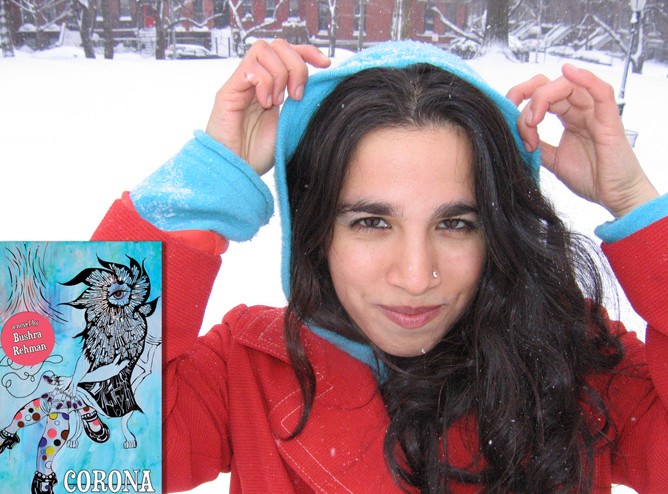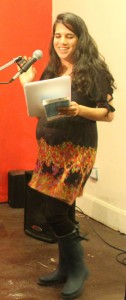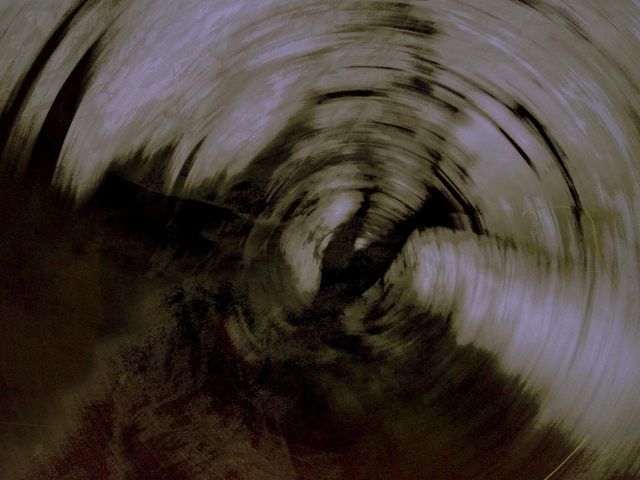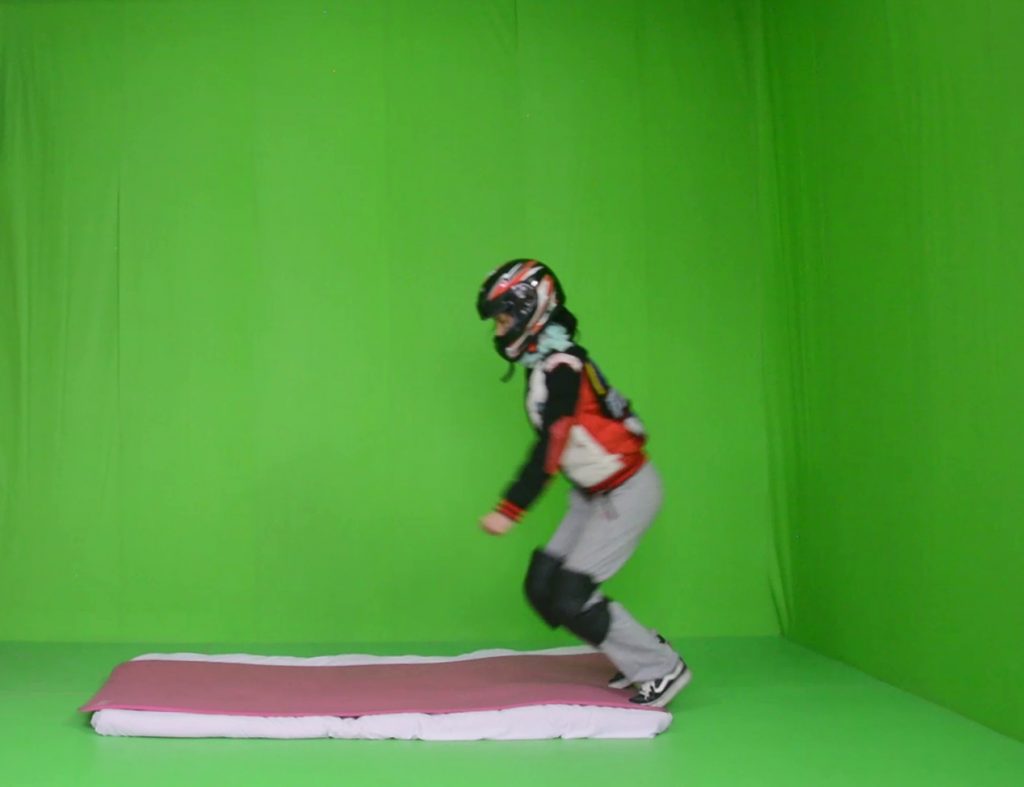Swati Marquez interviews Bushra Rehman on her new work of fiction, Corona.

September 10, 2013
I have been waiting for Bushra Rehman’s novel Corona for at least 14 years. Bushra and I first met at a South Asian Women’s Creative Collective (SAWCC) meeting in 1998 at the St. Marks’ Location of the Asian American Writers’ Workshop. Vividly, I remember her performing the following year for SAWCC’s “Tattoo This!” fundraiser and artists showcase at the Joseph Papp Public Theater—the petite poet towered in all black, a flowing skirt, combat boots, shaved head, and read “Marianna’s Beauty Salon” with incredible conviction and poise. From that performance, it was clear Bushra was a gifted storyteller, one who could weave keen observation, personal experience, creative imagination, and spiritual allegory with her stories. It was also clear that she had deep roots in Corona, Queens, and that she would be returning there in her writing.
The protagonist in Bushra’s novel, Razia Mirza, is a Pakistani woman who grew up in a tight Muslim community within a multi-ethnic enclave in Corona. As a young woman, Razia rebels, is ex-communicated, hits the road, and finds herself bound for Salem, Massachusetts, where she finds a job role-playing a hapless Puritan from the 1630s, sixty years before the notorious hangings. The novel weaves back and forth between her childhood in Corona and her young adult adventures on the road and in New York City, painting a complex portrait of Razia, who always seems to return to a place that’s not quite home.
Bushra’s connection to the Asian American Writer’s Workshop also runs deep. I had the good fortune to be a student with Bushra in Jessica Hagedorn’s “Gangster of Fiction” workshop at the AAWW in 2004. Four years later, Bushra taught a Memoir course that I took called “Two Truths and a Lie”, and then last year we read together at SAWCC’s Litfest Mixtape reading at the Workshop. Over time, I have seen Bushra develop as a writer and performer, and seen glimpses of Corona in progress. I drew upon those memories and experiences in this email interview with the novelist.
Join Bushra Rehman and other Queens-based writers this Friday, September 13, for a salon-style reading to celebrate her new novel. See here for more info.
Swati Marquez: In an interview with Karen Russell in Poets & Writers‘ annual roundup of the summer’s best debut ficion, you referred to the novel’s protagonist Razia as an “alter ego.” When did Razia come to you? Was there a particular story in Corona where she first appeared?
Bushra Rehman: I knew even as I was living through certain adventures that I would write about them one day, but the voice took many years to find. The first time Razia appeared to me was in a story that is not in the final collection—it’s called “Me and the Gang Rapist.” In this story, Razia boards her first Greyhound bus bound for Maine and she ends up sitting next to a gang rapist who is boasting about his crimes and hitting on her at the same time. Razia wonders if she really has ended up running off with the devil, just as her parents are imagining.
This was when Razia’s adult voice first came to me. The voice of the childhood stories came to me at the Workshop while I was teaching a creative non-fiction class for teenagers with Ed Garcia. We did the classic “Where I’m From” writing exercise inspired by Willie Perdomo’s poem. I don’t always get to write with my students, but that day I did, and I wrote the poem, which became the opening pages of Corona. Once I started writing about Corona I couldn’t stop. More and more hybrid poem-stories kept coming up. The more I wrote, the more I wanted to use poetry to show the beauty of a place that others would just see as a run-down impoverished neighborhood.
At first I thought I was writing two separate books, but then I realized, with the help of some amazing readers, including Chitra Ganesh and Sa’dia Rehman, that all these stories were part of the same book.
When did you realize you were writing a novel? Did you write some short stories first? Did you know the format of your novel would be linked stories?
I knew I wanted to write a novel from the beginning. At first I did plan on having it flow in a more traditional manner, but no matter how much I tried, the book refused to behave. I couldn’t force it to be any other way than it wanted to be.
Once I gave up on the idea of it being a straightforward narrative, I got excited about writing a story that was structured like a poem with omissions, illogical leaps, and dislocations in time and space. I kept thinking of the idea of negative space. One of the key moments, Razia’s disownment scene, is never written about directly, only alluded to again and again. It is the void, the black hole around which all the action of the novel circles.
Corona will always be special to me because I was learning how to write fiction even as I wrote it. I had to really figure out how to make a poem into a vignette into a chapter and then into chapters that made sense together. But I approached it all with a poet’s mind. I wanted every piece to stand on its own.

How did you decide the order of the stories?
I think it took me as many years to find the structure as it did to write the stories. There are eleven chapters, 11! possibilities (39,916,800 in case you’re wondering). I felt like I tried every one. When Corona came together as it is, I practically heard a click, like a car seat going into place, and the book was done.
Major inspiration came from Andy Goldsworthy’s A Collaboration with Nature, the quilts of Gee’s Bend, Chris Abani’s Graceland and Fernando Meirelles and Kátia Lund’s film based on the book City of God by Paulo Lins. The final order was based on poetic logic and the symbolism of certain objects, but I won’t over-explain it here. There is a code if readers want to find it.
When did you realize you were a writer? Was it an identity you embraced automatically or did you ever have to wrestle with it?
It was always very clear to me from the time I was a child that I was going to be a writer. I used to play this game where I’d sit in our attic, drinking lots of iced tea and staring off into space. I thought this was what the writer’s life would be. I wish!
I think my loved ones have wrestled with my identity more than me—people who can’t understand why I would want to take a job where you don’t make any money and where you are pretty much obsessed, but the answer of course is that it’s not a job, it’s a calling, and I got the call early.
In your ‘Two Truths and a Lie” memoir class, you suggested that we all make writing contracts with ourselves for the duration of the course, from “I will write 10 minutes a day” to “I will write 20 hours a week.” Anything worked as long as we kept them. Have you made writing contracts?
I haven’t written out a contract for myself in a long time, but I pretty much have an understanding that the ideal state for me is to write at least 1,000 words a day. I got this idea from Stephen King’s fabulous book On Writing. There are two pieces of King’s advice I’ve taken to heart: to write 1,000-2,000 words a day and edit 10 percent off of what you think is your final draft. But I don’t mean this to scare people. I know this is not possible for everyone every day, which is why the contract can be helpful. It’s meant for a limited period of time so people can make contracts with themselves periodically to push through a piece of work or dedicate a certain amount of time to a project.
In the same memoir class, you had us do a mapping exercise, where we were supposed to leave things out of our map, and develop it slowly. We then compared our maps to the NYC Transit subway map. In the chapter “The Old Italian” you include this map:
railroadtracksrailroadtracksrailroadtracks
Saima’s house Shahnaaz’s house
Lucy’s house Old Italian’s house
Did you do these mapping exercises, as you wrote Corona?
My drawers are filled with drawings, maps, strange number charts that only make sense to me. The idea for the exercise you mentioned was inspired by Peter Turchi’s Maps of the Imagination which is a phenomenal book.
In your book, real figures like Raghav (“the desi George Michael”), Amitav Ghosh, and DJ Rekha make appearances. You also incorporated real events, such as Bhangra Against Bush, and post-9/11 protests. How did you decide to keep some characters and scenes by their recognizable names, while others were fictionalized?
In the story “Bhangra Blow-Up”, which appears towards the end of Corona, I wanted to create a record of our times, of the whole under and above ground South Asian American Artist and Activist world. I kept the real names of some key figures for that reason.

Can you talk about different community organizations that you have been involved with and how that has helped your writing?
The moment I walked into the basement Jimi Hendrix once lived in, where the Asian American Writers’ Workshop was previously located and SAWCC meetings were held, my life changed. That night and many nights after, being among these talented women, experiencing work whose language and symbolism I understood was something I’d been craving without even knowing it. The SAWCC fundraiser “Tattoo This!” was one of my first readings. When I got on stage and read, I felt as if I had discovered a super power I didn’t know about.
If SAWCC was the spark, the AAWW has been the fuel that has consistently provided a space for me to try new work and to teach workshops where I learn as much as my students. I’m eternally grateful for both.
William Faulkner is known for saying, “In writing, you must kill all your darlings.” Can you talk about your revision and editing process? Have you had to kill any darlings?
This was a phrase one of my favorite teachers, Michael Cunningham, used to say all the time and I really took it to heart. But I don’t kill my darlings forever. I keep them in a file to re-use later. Corona is a pretty short book compared to what it could have been. Sometimes I look at it and think: It took me ten years to write this? But then I remember there are hundreds of pages and a number of stories that I cut out of the final draft—that’s all work I can still mine.
I fondly remember this particular exercise from your memoir course: shortening a two-page Gilgamesh synopsis to 14 lines. Seeing the same text sliced and diced in different ways was astounding. How do you approach the editing process?
I love teaching. Especially when I make up a new exercise and it works. This was an example where I could say until the cows came home that editing was a creative process, but until I gave everyone the same text to edit and to see what they came up with, they wouldn’t believe me.
Can you describe the writing-to-book process?
Do you mean publishing? All I can say about it for now is that most writers put the cart before the horse and think of publishing before they think of writing. I would advise against that because it can be very limiting. It doesn’t allow the work the time it needs to grow.
Five years ago, you gave us this advice on how to be a writer: “Write everyday. Be a good listener. Be compassionate.” What advice would you give now?
I just wrote a series of articles for Poets & Writers on thoughts about writing, which I’d love to share in answer to that question. Here’s the first, the second, and the third. But the short answer is I’d add: keep your body and mind healthy, unplug from the computer once in a while (or most of the time) and don’t forget to be alive.
What’s next for Razia? Will we see her again?
In one of the last stories in Corona, Razia is leaving NYC to live in California. The next novel covers her adventures in Oakland, which are enough to fill an entire book. It will take on the form of a more traditional novel; it’s a straight-through narrative. But I’m hoping this one won’t take ten years to write.
What’s next for Bushra?
I just gave birth to my daughter in May, so in addition to the upcoming Razia adventures, there are the adventures of having an amazing child to hang around with.



